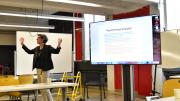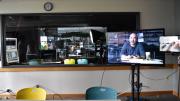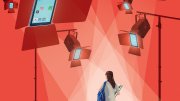Academic staff members across the University who plan and design teaching spaces gathered for a week of discussion and site visits to exchange ideas on how to facilitate better learning through re-envisioning classrooms. Learning Spaces Week, organized by the Harvard Initiative for Learning and Teaching (HILT), included tours of innovative learning spaces across campus, including a fabrication lab at the Graduate School of Design equipped with 3D printers; a state-of-the-art video capture studio in Widener Library; and the “hives” classrooms at Harvard Business School—all wrapped around speeches and panel discussions.
According to HILT director Erin Driver-Linn, improving learning spaces surfaced as the most important issue when she discussed priorities for enhancing the quality of instruction at Harvard with administrators and support staff from around the University. By organizing an event where participants can visit and learn from examples of innovative spaces, HILT hopes to convene and inform a network of people who have a stake in improving the learning environment.
Mallinckrodt professor of physics Melissa Franklin, who delivered the opening address, said Harvard needs more spaces where students can learn in a hands-on manner. Though the Carpenter Center for the Visual Arts and the Graduate School of Design feature well-equipped workshops, she could hardly find similar spaces at Harvard that are open to all students. “There is a very strong sense of the words at Harvard and not a very strong sense of the hands,” she observed. A few years ago, when she proposed a requirement for undergraduates to complete a course that predominantly involves hands-on learning, it was met with “fire and flames,” as many faculty members expressed discomfort with the idea of learning without books.
Transforming learning spaces at Harvard is largely about transforming how faculty and students feel when walking into a place, Franklin said. The goal should be to make everyone feel comfortable and welcome, not embarrassed or awkward. If students get the idea that they are not allowed to alter the original setups of a room, they may not behave as comfortably as they would otherwise.
Franklin was speaking at the SciBox (Science Center 302), an innovative classroom modeled on a black-box theater. These 2,500 square feet of open space are sometimes used for classes during the day and rehearsals for student performance groups at night. Everything in the room—tables, chairs, white boards, a 75-inch TV—is on wheels, which encourages mobility and collaboration in the classroom. Spaces like the SciBox are designed to make students feel that it is permissible to experiment and make mistakes. “If you don’t break things,” Franklin said, “you are not learning anything.”
At a large, decentralized institution like Harvard, there are often more resources than people know about. Administrators are making efforts to gather and distribute information on learning spaces (with the HILT-organized program complementing that effort). Deborah Sears, an event participant who serves as the learning spaces instructional technologist at Harvard University Information Technology, said her post was just created a few months ago to fill a gap in coordinating the various groups that have a stake in learning spaces. In her new role, she will be a bridge between faculty members and planners, determining the types of spaces the University most needs and how to make them materialize. Currently, it is a challenge to know how all learning spaces at the College are being used because majority are controlled by individual departments, she said. However, as the Registrar’s Office begins to fold these spaces into the online RoomBook system, this information will become more available, which facilitates the planning of future renovations.
One concrete result of Learning Spaces Week is a three-dimensional online map of Harvard campus with “pins” indicating innovative learning spaces like those showcased during the event. Clicking on each pin brings into view a host of information on the room—its capacity, facilities, and contact person. The map is the brainchild of Stephen Ervin, the Graduate School of Design’s assistant dean for information technology, who saw the need for gathering such information systematically. Though the map is currently accessible only to the organizers and participants of the event, discussions on making it available to the entire Harvard community are under way. “If you take seriously our president’s claim about One University,” he said, “then a student here at the design school ought to know about the great visualization lab they have over at the archaeology department. But I happen to know that most of them don’t.”













